Brands
Hydrogen Fuel Cell Electric Vehicles FCEVs; Technology and features
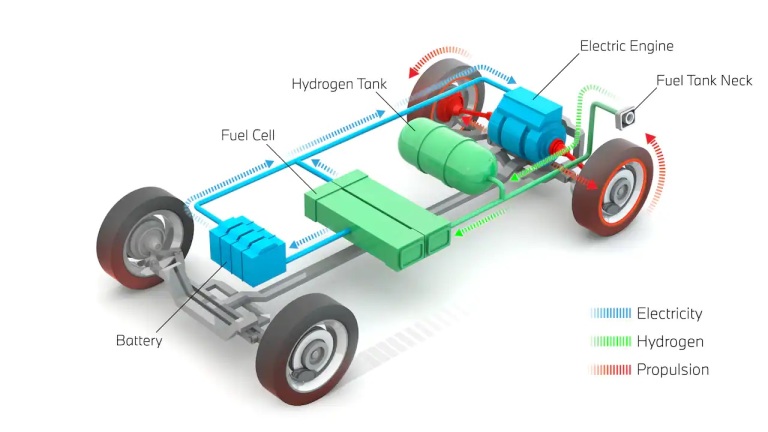
Fuel cell electric vehicles (FCEVs) are a type of electric car that use fuel cells powered by hydrogen fuel to generate electricity that power the motor instead of relying primarily on a lithium-ion battery pack. They are more efficient than conventional internal combustion engine vehicles and produce no tailpipe emissions; they only emit water vapor and warm air. FCEVs and the hydrogen infrastructure to fuel them are in the early stages of implementation.
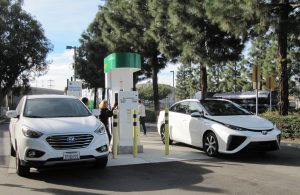
Hydrogen Fuel cell Electric Vehicles (Hyundai Tucson and Toyota Mirai) at the gas fueling station
How Fuel Cell Electric Vehicles work
FCEVs use a propulsion system similar to that of electric vehicles, where energy stored as hydrogen is converted to electricity by the fuel cell. FCEVs are fueled with pure hydrogen gas stored in a tank on the vehicle. Similar to conventional internal combustion engine vehicles, they can fuel in less than 4 minutes and have a driving range over 300 miles. FCEVs are equipped with other advanced technologies to increase efficiency, such as regenerative braking systems that capture the energy lost during braking and store it in a battery.
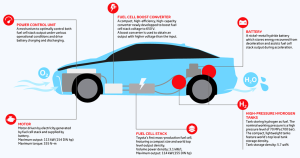
How FCEVs Works Infographic Fuel Cell Electric Vehicle components
The most common type of fuel cell for vehicle applications is the polymer electrolyte membrane (PEM) fuel cell. In a PEM fuel cell, an electrolyte membrane is sandwiched between a positive electrode (cathode) and a negative electrode (anode). Hydrogen is introduced to the anode, and oxygen (from air) is introduced to the cathode. The hydrogen molecules break apart into protons and electrons due to an electrochemical reaction in the fuel cell catalyst. Protons then travel through the membrane to the cathode.
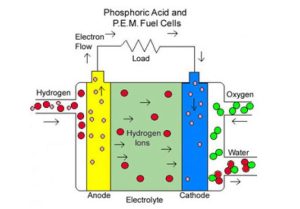
Proton-exchange membrane fuel cells (PEMFC)
The electrons are forced to travel through an external circuit to perform work (providing power to the electric car) then recombine with the protons on the cathode side where the protons, electrons, and oxygen molecules combine to form water. The electrons are gathered by the conductive current collector, which is connected to the car’s high-voltage circuitry, feeding the onboard battery and/or the motors that turn the wheels.
Components of Fuel Cell Electric Vehicles

Hydrogen Fuel Cell Electric Vehicle Layout diagram for Toyota Mirai
- Hydrogen Tank: Hydrogen gas is stored in carbon-fiber reinforced tanks to provide fuel to the fuel-cell stack
- Fuel Cell Stack: An aggregate of numerous fuel cells that combine oxygen and hydrogen to generate electricity and power the electric motor
- Electric Motor: Powers the car using energy produced in the fuel cell stack
- Battery: Captures energy from regenerative braking and provides additional power to the electric motor
- Exhaust: The byproduct of the reaction occurring in the fuel cell stack is water vapor, which is emitted through the exhaust
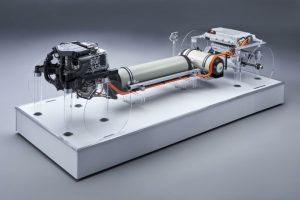
Powertrain for the BMW iX5 Hydrogen.
Hydrogen Fuel application in automobiles
Hydrogen is a fuel compatible for automotive applications in form of a combustible fuel for internal combustion engines or as a feedstock for hydrogen fuel cell stack to generate electricity to drive electric motors powering the vehicle.
Hydrogen is a diatomic molecule, two hydrogen atoms sharing a valence shell. You can fill a balloon with hydrogen and oxygen gases and they will not instantly form water. To get water out of this you need to ‘excite’ the sets of hydrogen and oxygen atoms sufficiently to ‘unstick’ them. Of course, using hydrogen in a combustion chamber mixed with air is pretty straightforward (remember it’s a 2 to 1 mix of hydrogen and oxygen – and air contains roughly 21% oxygen).
However, there is a problem with hydrogen as a fuel source for an internal combustion engine. While it has incredible energy density per pound – about three times that of gasoline, it is, unfortunately, the lightest element in the universe, meaning that it has to be squeezed mightily to get any density at all. Even compressed hydrogen doesn’t come close to the energy density of gasoline by volume. So, given the low efficiency of an internal combustion engine compared to an electric motor, hydrogen isn’t an effective solution for ICE.
But when comparing compressed hydrogen to batteries the tables turn. Hydrogen in a fuel cell stack can provide plentiful electricity allowing good power and range. And even better, unlike batteries, as the store of hydrogen drains the fuel cell stack still produces rated voltage. Batteries decrease available voltage as they drain (and that’s why so much effort is spent on battery management and not allowing batteries to discharge beyond a very healthy reserve).
Benefits of Fuel Cell Electric Vehicles
- Fun to drive
- Instant torque and smooth, consistent power
- High-tech
- Low maintenance
- Zero emissions
- Fast refueling (3-5 minutes)
- Access to carpool lanes and other incentives
- Attractive lease pricing often bundled with free fuel/maintenance
- Hydrogen is considered an alternative fuel under the Energy Policy Act of 1992 and qualifies for alternative fuel vehicle tax credits.
Availability
Fuel cell cars are available for sale or lease by major automakers like Toyota, Hyundai, Honda, BMW in popular vehicle types, including sedans and compact SUVs examples including Toyota Mirai, Hyundai Tucson FCEV, River simple Rasa, Honda Clarity Fuel Cell, Hyundai Nexo, BMW iX5 Hydrogen. As the numbers increase, stakeholders are working to ensure hydrogen is widely available to drivers. Search vehicles to see available models.
Fuel Cell Electric Vehicles Performance
Hydrogen fuel cell cars are quiet, very energy efficient, produce no emissions and have equivalent range and performance to gasoline counterparts. Drivers identify range, refueling time, emissions, power and performance as valuable vehicle characteristics.
The 2016 model year Mirai has a total EPA range of 502 km (312 mi) on a full tank, with a combined city/highway fuel economy rating of 66 mpg‑US (3.6 L/100 km; 79 mpg‑imp) equivalent (MPG-equivalent), making the Mirai the most fuel-efficient hydrogen fuel cell vehicle rated at the time by the EPA, and the one with the longest range. In August 2021, the second-generation Mirai set a world record of traveling 1,360 km (845 mi) with a full tank of 5.65 kg hydrogen.
Cost of Fuel Cell Electric Vehicles
While a fuel cell car acquisition can cost more than comparable sized conventional cars, current leasing packages usually include fuel, service and maintenance to compensate. With these incentives included, total cost of ownership for a fuel cell car can be comparable to conventional cars.
Fuel Cell Electric Vehicles Fueling
Fuel cell cars can carry enough hydrogen fuel for 300-400 miles of range and their tanks can be refilled as quickly as that of a standard car’s gas tank. Refueling an FCEV’s hydrogen tanks is about as fast as filling up a gas car, one serious advantage that hydrogen cars have over battery EVs. You just pull up to the fueling station, connect the hose, and the tank is full in around five minutes.
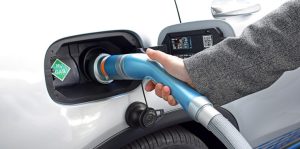
Hydrogen Fuel refilling in a FCEV
Current lease deals often include up to three years of complimentary fuel. At the pump, hydrogen sells for considerably more than gasoline; however, a fuel cell car travels about twice as far as a conventional car on an equivalent amount of fuel.
Fuel Cell Electric Vehicles Safety
FCEV can have multiple hydrogen gas tanks on board. To put safety in check, since hydrogen can be highly flammable if handled improperly, those fuel tanks are thick-walled, pressurized, and tested to ensure crash safety. Failsafes are also built into the vehicles that ensure the hydrogen is dispersed and released if, for example, the fuel cell is removed or overheats.
Pros and Con of Fuel Cell Electric Vehicles
| Pros | Cons |
| · No vehicle emissions other than water vapor.
· Fuel economy equivalent to about twice that of gasoline vehicles. · Hydrogen is abundant, and can be made from renewable energy. |
· This space-age technology is expensive.
· Acceptable range requires extremely-high-pressure, on-board hydrogen storage. · Few places to refuel. · Hydrogen is very expensive to transport and there is no infrastructure in place yet. · Currently hydrogen fuel is made from nonrenewable natural gas in a process that creates enormous CO2 emissions. |
Fuel Cell Electric Vehicles FCEVs Vs Battery Electric Vehicles BEV
Hydrogen vehicles have a lot in common with battery-powered cars such as the Ford Mustang Mach-E, Toyota bZ4X and the Tesla Model 3. Both battery EVs and FCEVs use electricity instead of combustible fuel, they both have electric motors and onboard batteries, and neither one emits harmful gasses. The differences come down to infrastructure, fuel, and availability.
Battery EVs have a more robust infrastructure for public recharging than hydrogen vehicles. While still not as prevalent as gas stations, there are now thousands of EV recharging locations across the US. Meanwhile, all of the hydrogen refueling stations in the US are located in California, so long road trips are out of the question.
The cost of refueling is also worth considering. Since it’s more costly to produce hydrogen gas for FCEVs at the moment, filling up your FCEV is more expensive than it is for an electric car. However, a hydrogen vehicle can be refueled many times faster than an EV and can store excess electrical energy in its battery, allowing it to recharge while driving. Battery EVs, by contrast, need to be plugged into the grid to regain most of their power.
Of course, the biggest issue is that FCEVs aren’t widely available in the US yet. Only a few manufacturers are selling them to the public; the Toyota Mirai and Hyundai Nexo are the most prevalent names in the race currently.
Despite hydrogen’s limitations, countries around the world are seeing it as a viable alternative energy source for everything from cars and buses to airplanes. If we can find a cost-effective way to make hydrogen production more environmentally friendly and build out the necessary refueling infrastructure, FCEVs could mean a huge leap forward for green transportation.
Fuel Cell Electric Vehicles FCEVs Technology Reviews and critics
Elon Musk founder of SpaceX and co-founder and CEO of Tesla has described hydrogen fuel cells as “mind-bogglingly stupid,” and that is not the only negative thing he has had to say about the technology. He has called them “fool cells,” a “load of rubbish,” and told Tesla shareholders at an annual meeting years ago that “success is simply not possible.”
Musk found a surprising source of support in 2017, when Yoshikazu Tanaka, chief engineer in charge of the Mirai, told Reuters, “Elon Musk is right — it’s better to charge the electric car directly by plugging in.” But the Toyota executive added that hydrogen is a viable alternative to gasoline. Toyota chairman Takeshi Uchiyamada told Reuters at the same Tokyo auto show in 2017, “We don’t really see an adversary ‘zero-sum’ relationship between the battery powered electric vehicle and the hydrogen car. We’re not about to give up on hydrogen electric fuel-cell technology at all.”
Fuel Cell Electric Vehicles FCEVs cannot get away from the poor conversion efficiency, but hydrogen in (for example) SmartNet Service Stations, provides a way of storing large amounts of energy, where batteries cannot compete.

-

 Brands2 years ago
Brands2 years agoRevBio Tetranite Regenerative Bone Adhesive Actions and Microgravity Technology.
-
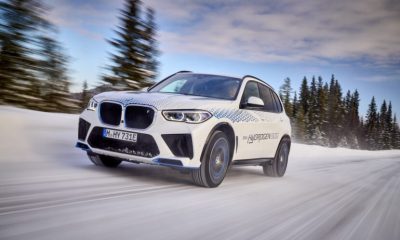
 Brands2 years ago
Brands2 years agoBMW ix5 Hydrogen; Features, Release date, Price and specs.
-
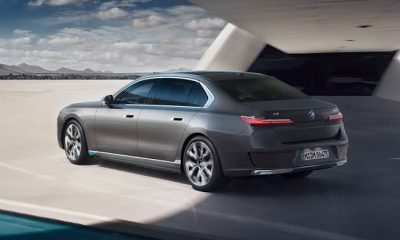
 Brands2 years ago
Brands2 years agoBMW i7 All Electric Executive Sedan Features and Price
-

 Lifestyle2 years ago
Lifestyle2 years agoJeff Bezos; Networth, Career and lifestyle
-
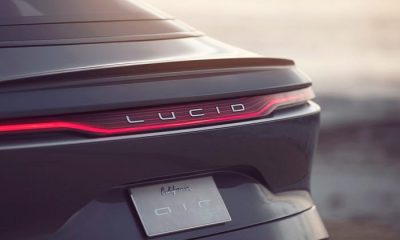
 Brands2 years ago
Brands2 years agoLucid Air; models, specifications, Features, price and range.
-

 Machinery2 years ago
Machinery2 years agoSmall Modular Reactors; Future of Modern Nuclear power generators
-
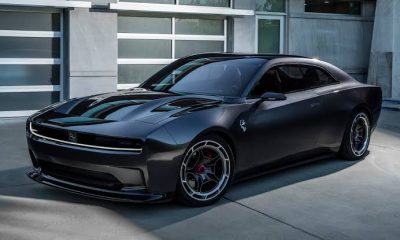
 Brands2 years ago
Brands2 years agoDodge Charger Daytona SRT EV Concept; Electric muscle car specs, release date and price
-
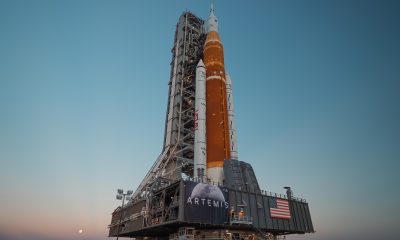
 Brands2 years ago
Brands2 years agoSpace Launch System SLS; NASA’s Artemis Mega Rocket for Deep Space Exploration
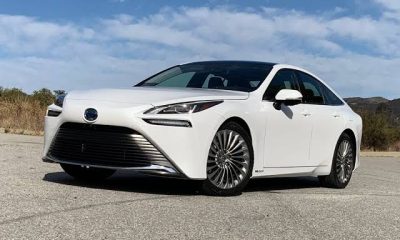

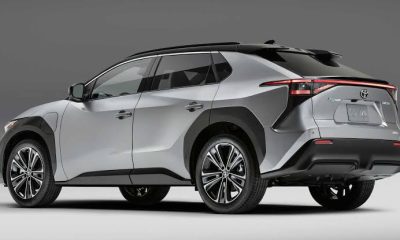

Pingback: BMW ix5 Hydrogen; Features, Release date, Price and specs.
Pingback: Hydrogen Fuel Green Fuel of the future, types and production processes.
Pingback: How Electric Cars work, Electric Vehicle types and Prices.